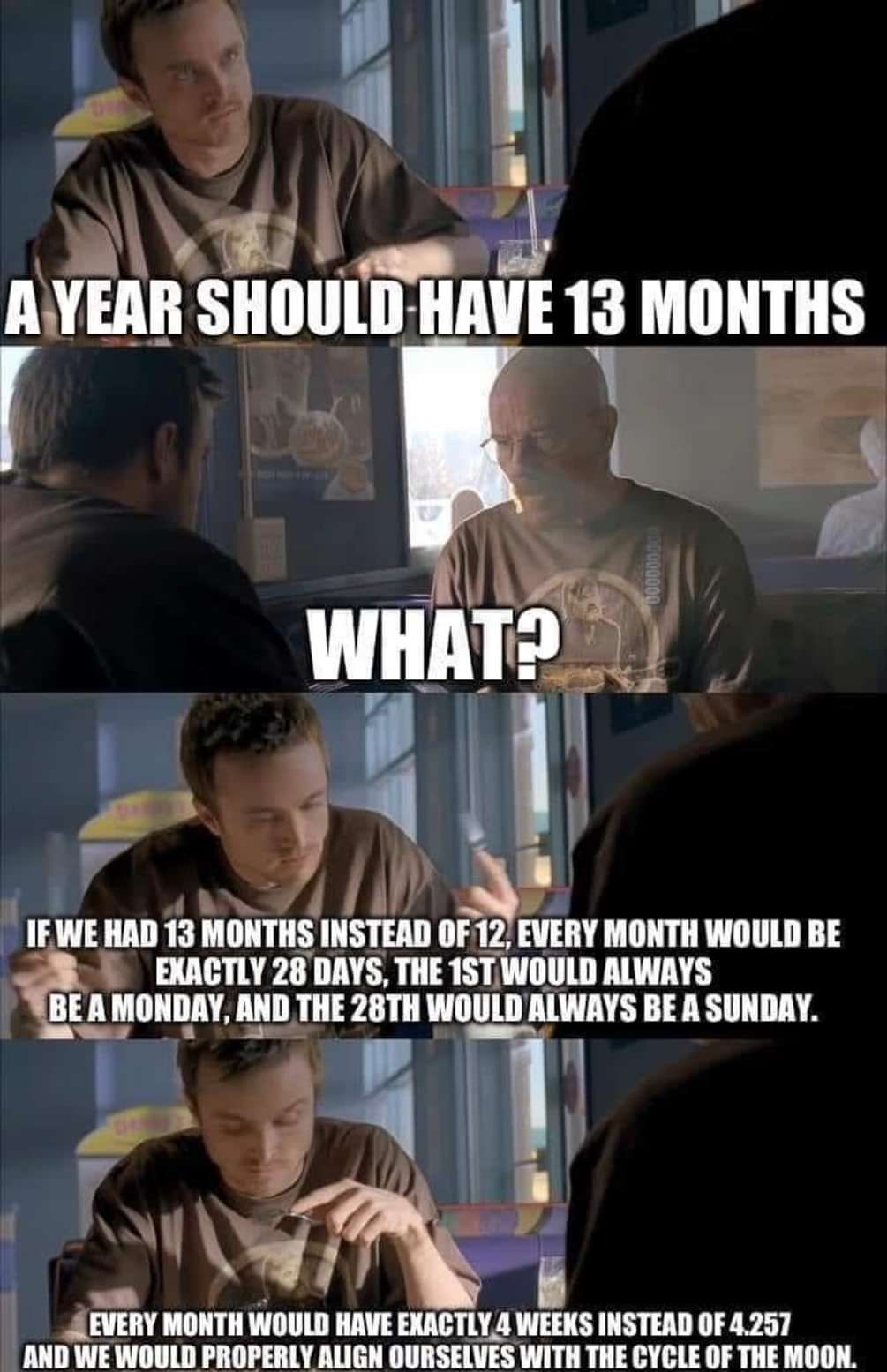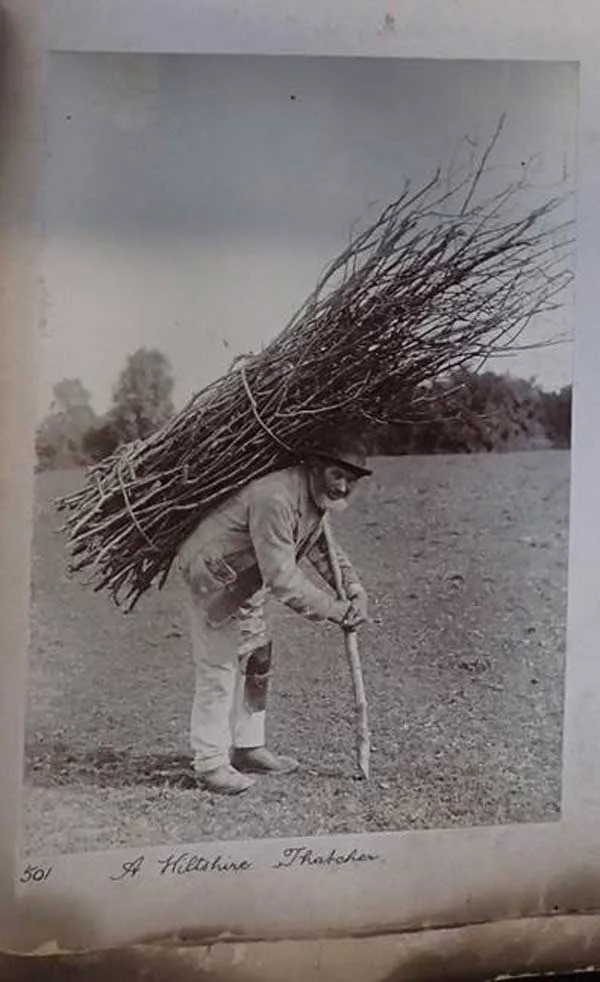Mildly interesting
-
My in ground fig tree is giving one last heroic effort to ripen all of its fruits. Once they start turning purple, it’s just a few days. Almost the whole tree full just started turning purple.

I’ve gotten about 20 figs from this tree over the summer. Now I’ll get 50 in the next week. Hopefully. If you charted figs vs time, it would look like the climate change hockey stick - not a pleasant thought, what with humanity’s fast approaching extinction due to climate change.
My other trees in pots were unproductive this year, stunted and immature. Much like Palestinians. Not a pleasant thought, what with humanity’s fast approaching extinction due to them.
-
28 x 13 = 364. What do you do with the extra day (plus of course the leap year day)?
Though it does seem as though the months are kind of messed up.
@taiwan_girl said in Mildly interesting:
28 x 13 = 364. What do you do with the extra day (plus of course the leap year day)?
Though it does seem as though the months are kind of messed up.
https://www.inverse.com/article/41737-28-day-calendar
“The idea is simple. Each month has four, seven-day weeks, making a total of 28 days. There are 13 months in a year, totaling 364 days, with a new month in between June and July called “Sol” to mark the summer solstice. The leftover day is a special Year Day, with two such days every four years”
-
@taiwan_girl said in Mildly interesting:
28 x 13 = 364. What do you do with the extra day (plus of course the leap year day)?
Though it does seem as though the months are kind of messed up.
https://www.inverse.com/article/41737-28-day-calendar
“The idea is simple. Each month has four, seven-day weeks, making a total of 28 days. There are 13 months in a year, totaling 364 days, with a new month in between June and July called “Sol” to mark the summer solstice. The leftover day is a special Year Day, with two such days every four years”
@George-K said in Mildly interesting:
@taiwan_girl said in Mildly interesting:
28 x 13 = 364. What do you do with the extra day (plus of course the leap year day)?
Though it does seem as though the months are kind of messed up.
https://www.inverse.com/article/41737-28-day-calendar
“The idea is simple. Each month has four, seven-day weeks, making a total of 28 days. There are 13 months in a year, totaling 364 days, with a new month in between June and July called “Sol” to mark the summer solstice. The leftover day is a special Year Day, with two such days every four years”
It makes sense. I like the idea. Probably never happen, but I like it. (Interesting that Kodak used it as a company calendar)
From the article:
It may sound like a small detail to some, but don’t forget that Microsoft never released a version 13 of Office, and data from 2015 showed 574 Manhattan condos lack a 13th floor. Don’t underestimate the power of superstition.
That is mainly US based. In north Asia, the number 4 has a similar sound to death, so many floors of buildings don't have a 4th floor. It skips from 3 to 5.
-
@George-K said in Mildly interesting:
@taiwan_girl said in Mildly interesting:
28 x 13 = 364. What do you do with the extra day (plus of course the leap year day)?
Though it does seem as though the months are kind of messed up.
https://www.inverse.com/article/41737-28-day-calendar
“The idea is simple. Each month has four, seven-day weeks, making a total of 28 days. There are 13 months in a year, totaling 364 days, with a new month in between June and July called “Sol” to mark the summer solstice. The leftover day is a special Year Day, with two such days every four years”
It makes sense. I like the idea. Probably never happen, but I like it. (Interesting that Kodak used it as a company calendar)
From the article:
It may sound like a small detail to some, but don’t forget that Microsoft never released a version 13 of Office, and data from 2015 showed 574 Manhattan condos lack a 13th floor. Don’t underestimate the power of superstition.
That is mainly US based. In north Asia, the number 4 has a similar sound to death, so many floors of buildings don't have a 4th floor. It skips from 3 to 5.
@taiwan_girl said in Mildly interesting:
Don’t underestimate the power of superstition.
When I worked downtown, one of the hospital buildings didn't have a 13th floor. Since they rebuilt, the new ones do.
-
@George-K said in Mildly interesting:
@taiwan_girl said in Mildly interesting:
28 x 13 = 364. What do you do with the extra day (plus of course the leap year day)?
Though it does seem as though the months are kind of messed up.
https://www.inverse.com/article/41737-28-day-calendar
“The idea is simple. Each month has four, seven-day weeks, making a total of 28 days. There are 13 months in a year, totaling 364 days, with a new month in between June and July called “Sol” to mark the summer solstice. The leftover day is a special Year Day, with two such days every four years”
It makes sense. I like the idea. Probably never happen, but I like it. (Interesting that Kodak used it as a company calendar)
From the article:
It may sound like a small detail to some, but don’t forget that Microsoft never released a version 13 of Office, and data from 2015 showed 574 Manhattan condos lack a 13th floor. Don’t underestimate the power of superstition.
That is mainly US based. In north Asia, the number 4 has a similar sound to death, so many floors of buildings don't have a 4th floor. It skips from 3 to 5.
@taiwan_girl said in Mildly interesting:
It makes sense.
I hate to tell you this, but the orbital speed of the Earth is slowing.
This is just like Climate Change.
It is happening with or without Daylight Saving.
A year won't have 365 days forever.
-
@taiwan_girl said in Mildly interesting:
It makes sense.
I hate to tell you this, but the orbital speed of the Earth is slowing.
This is just like Climate Change.
It is happening with or without Daylight Saving.
A year won't have 365 days forever.
@Copper said in Mildly interesting:
A year won't have 365 days forever.
But I don't think we have to worry about it. That will be something for our new Robot masters to concern them.
-
In traveling carnivals of yore, a ‘Geek’ was a guy who bit the heads off chickens. And swallowed them.
-
In traveling carnivals of yore, a ‘Geek’ was a guy who bit the heads off chickens. And swallowed them.
@jon-nyc said in Mildly interesting:
In traveling carnivals of yore, a ‘Geek’ was a guy who bit the heads off chickens. And swallowed them.
So not much has changed
-
This guy will be fun to follow over the next decade or more. I hope he doesn't get injured.
Link to video -
An original photograph of the mysterious figure on the cover of Led Zeppelin IV has been discovered in an old photo album - and he's been identified
Led Zeppelin's iconic fourth album was released 52 years ago today (November 8), and its cover art has been the subject of much conjecture in the decades since, with talk of runes, tarot and the occult. One of the greatest mysteries has been the identify of the painted figure on the front cover, a stooped man with a burden of sticks on his back, commonly referred to as 'The Hermit'.
The original story goes that Robert Plant found the painting in a second-hand store in Reading, Berkshire, while on his way to recording sessions at Headley Grange in Hampshire. Some have claimed that the old man is Henry "Brusher" Mills, a well-known Victorian-era snake catcher who lived in Hampshire's New Forest, while Jimmy Page reportedly noted the figure's resemblance to ‘Old George’ Pickingill – who had first instructed Aleister Crowley in the occult – and made the painting a feature of the cover art. Typically, Page has been reluctant to provide further detail.
"‘The cover was supposed to be something that was for other people to savour rather than for me to actually spell everything out," he told The Times in 2010. "Which would make the whole thing rather disappointing on that level of your own personal adventure into the music."
Now the mystery has been solved, after the original photograph on which the painting was based was found during research for an upcoming exhibition at the Wiltshire Museum in Devizes. The picture was discovered in an old album by Brian Edwards, a Visiting Research Fellow with the Regional History Centre at the University of the West of England, who, being a Led Zeppelin fan, recognised the image immediately.
"Led Zeppelin created the soundtrack that has accompanied me since my teenage years," says Edwards. "So I really hope the discovery of this Victorian photograph pleases and entertains Robert, Jimmy, and John Paul."
Ernest Howard Farmer's photo of 'The Wiltshire Thatcher'
Further research was able to able to suggest likely candidates for both the photographer and his subject. A part signature matching the writing in the album suggests the man behind the camera was photography teacher Ernest Howard Farmer (1856-1944), while the stooped figure is likely to be Lot Long – also known as Lot Longyear – a thatcher (a craftsman who installs traditional thatched roofing), from the small town of Mere in southwest Wiltshire. Lot was born in 1823 and died in 1893.
Farmer's photograph will be included in an exhibition, Wiltshire Thatcher: a Photographic Journey through Victorian Wessex, which is scheduled to run at the Wiltshire Museum in spring 2024.
"Through the exhibition, we will show how Farmer captured the spirit of people, villages and landscapes of Wiltshire and Dorset that were so much of a contrast to his life in London," says David Dawson, Director of the museum. "It is fascinating to see how this theme of rural and urban contrasts was developed by Led Zeppelin and became the focus for this iconic album cover 70 years later."
-
The term 'freelancer' was originally used to describe a mediaeval mercenary who put out his services to hire





